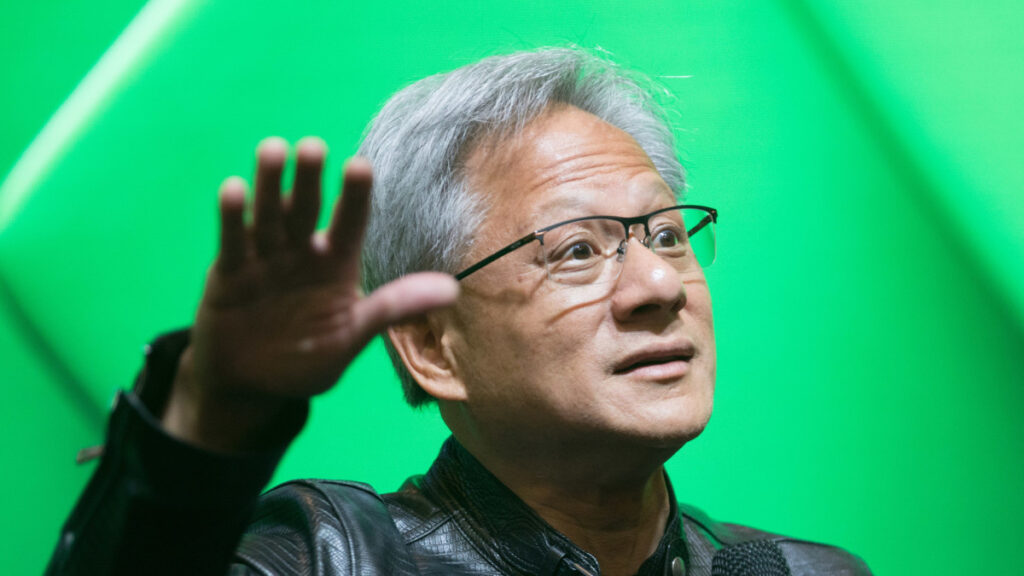Nvidia is a Goliath with the largest stock market capitalization, hundreds of billions in sales, and a cult-like following on Wall Street.
It wasn’t always that way. Before Nvidia rode the artificial intelligence wave to a $4 trillion market cap, becoming the largest member of the S&P 500, it was a niche semiconductor play carving out market share in video game consoles.
Nvidia’s CEO Jensen Huang deserves the credit for transforming its foothold in gaming into an AI juggernaut. He’s seemingly been early to major technological shifts involving high-powered processors, including cryptocurrency mining.
Nowadays, he’s set his sights on winning the agentic AI market, robots, and capturing an increasingly larger share of the global demand for faster, more efficient compute power, including in China.
Huang recently discussed what’s next for Nvidia during the company’s corporate conference call with investors.
Here are 10 quotes everyone should pay attention to regarding what’s next for the company and Nvidia’s stock price.
Image source: Shutterstock
1. China challenges remain, but upside is huge
“I’ve estimated to be about $50 billion of opportunity for us this year if we were able to address it with competitive products. And if it’s $50 billion this year, you would expect it to grow, say, 50% per year.”
Growing restrictions on the sale of next-gen technology caused Nvidia to halt sales of its H20, an AI chip specially designed for the Chinese market, earlier this year, forcing it to take a $4.5 billion write-down. Restrictions remain in place, but a recent deal that could mean the U.S. Government nets 15% of H20 revenue may clear the way to export licenses and demand.
Related: China pushes back after Nvidia deal sparks controversy
China is the world’s second-biggest computing market, and about half the planet’s AI researchers live there. If H20 sales resume, it could mean big bucks for Nvidia’s top line.
The company doesn’t include any China H20 sales in its guidance, but if the government cooperates, CFO Colette Kress says they could ship $2 billion to $5 billion in Q3.
2. Agentic AI inference is driving demand
“The amount of computation necessary for 1 shot versus reasoning agentic AI models could be 100x, 1,000x and potentially even more as the amount of research and basically reading and comprehension that it goes off to do…the amount of computation that has resulted in agentic AI has grown tremendously.”
Initially, all the AI activity was around developing large-language models, or AI chatbots, that could digest vast amounts of data to answer questions more meaningfully, displacing traditional search.
Now, the AI market is transitioning to agentic AI, AI tools that can assist — and sometimes replace — workers. Those AI agents are increasingly being deployed across most industries, representing an even larger source of demand for computing power and fueling increasing investment in data centers.
3. Robots represent a mega-billion growth opportunity
“We now are seeing a breakthrough in physical AI, in robotics, autonomous systems.”
It’s not just chatbots and AI agents — it’s also about deploying AI in physical machines, robots that can be used at home and on the manufacturing floor.
Nvidia says “Every industrial company will need to build 2 factories: 1 to build the machines and another to build their robotic AI.”
To meet the demand, Nvidia has launched Jetson Thor, a robotics computing platform.
Related: Nvidia Makes Bold Bet on Future as Earnings Hit
Nvidia says it has “over 2 million developers and 1,000-plus hardware, software applications, and sensor partners taking our platform to market,” including “Agility Robotics, Amazon Robotics, Boston Dynamics, Caterpillar, Figure, Hexagon, Medtronic, and Meta.”
Importantly, according to Nvidia, robots “require exponentially more compute on the device and in infrastructure, representing a significant long-term demand driver.”
4. A trillion-dollar market opportunity is on the horizon
“Over the next 5 years, we’re going to scale into with Blackwell, with Rubin and follow-ons to scale into effectively a $3 trillion to $4 trillion AI infrastructure opportunity. “
Huang believes that new AI models, AI agents, and AI-hungry robots will fuel significant demand for ongoing data center upgrades, translating into trillions of addressable market opportunities.
It’s not just the big players who are spending on AI, either. Huang points out that top “native-AI start-ups” attracted $100 billion in funding last year and $180 billion (so far) this year. Revenue at top native-AI companies could hit $20 billion in 2025, and Huang thinks it is possible that revenue could 10x for them next year. If so, it could accelerate the need for more data center capacity.
5. Hyperscalers aren’t done building out AI data networks
“CapEx has grown in just the top 4 CSPs by — has doubled and grown to about $600 billion. So we’re in the beginning of this build-out.”
Huang says the $600 billion in spending by the largest four hyperscalers is double what was spent two years ago, which means there’s a lot of demand for Nvidia’s AI chips and servers, like its next-gen Blackwell and GB300 rack-scale AI server platform.
Related: Hyperscalers’ AI spending boom isn’t over, says analyst
With inference ramping and physical AI looming, hyperscalers are incentivized to continuously upgrade existing infrastructure to handle workloads faster while consuming less energy, making upgrades increasingly profitable.
That should bode well for Rubin, Nvidia’s third-generation AI supercomputer set to launch in 2026.
6. Rivals will struggle to compete for AI market share
“Accelerated computing is unlike general- purpose computing. You don’t write software and just compile it into a processor. Accelerated computing is a full-stack co-design problem.”
Lots of attention is given to demand for ASIC chips as alternatives to Nvidia’s graphic processing units (GPUs).
Sales have undeniably grown for ASIC semiconductor plays, including Broadcom. Still, Huang is unfazed by the potential threat, believing a holistic approach that includes chips, servers, and the switches and cabling necessary to connect and run it all is what will win, rather than one-off solutions.
More Nvidia:
- Nvidia earnings face high bar on data-center demand, China deal
- Nvidia quietly buys more stock in AI infrastructure favorite
- Soros supercharges Nvidia stake, loads up on AI plays
Building soup-to-nuts solutions that work seemlessly isn’t easy, and that sets the bar high for rivals aiming to dethrone it.
“One of the advantages that we have is that Nvidia is available in every cloud,” said Huang. “We’re available from every computer company. We’re available from the cloud to on-prem to edge to robotics on the same programming model…so it’s sensible that every framework in the world supports Nvidia.”
Nvidia is firmly established as the go-to solution for AI research, development, and use, similar to how Microsoft became the must-have software for all PCs.
7. It’s not just chips and servers, it’s connectivity too
“We’re in our fifth generation now, to a scale-out switch, whether it’s Quantum or Spectrum-X Ethernet, to now scale across switches so that we could prepare for these AI super factories with multiple gigawatts of computing all connected together.”
Nvidia’s Spectrum-X Ethernet sales grew double-digits quarter-over-quarter in Q2, and sales have eclipsed a $10 billion run rate annualized.
InfiniBand and Spectrum switches and adapters increase network speed and stability, and their next-gen solution, Spectrum-XGS, will allow multiple data centers to be linked to create AI super factories. The networking associated with building AI-optimized data centers represents a major business in itself.
These products can improve network throughput from “65% to 85% or 90%,” says Huang, paying for themself. “You’ll get a return on it like you can’t believe,” said Huang.
8. The record-setting isn’t done yet
“This year is obviously a record-breaking year. I expect next year to be a record-breaking year.”
Nvidia is guiding total third-quarter sales of $54 billion, up $7 billion from Q2, without any China H20 revenue.
After Nvidia’s latest earnings, Wall Street analysts target total sales of $207 billion this fiscal year and $272 billion next year.
Todd Campbell owns Nvidia shares.
Related: Dan Ives drops blunt 4-word message on Nvidia’s next phase




